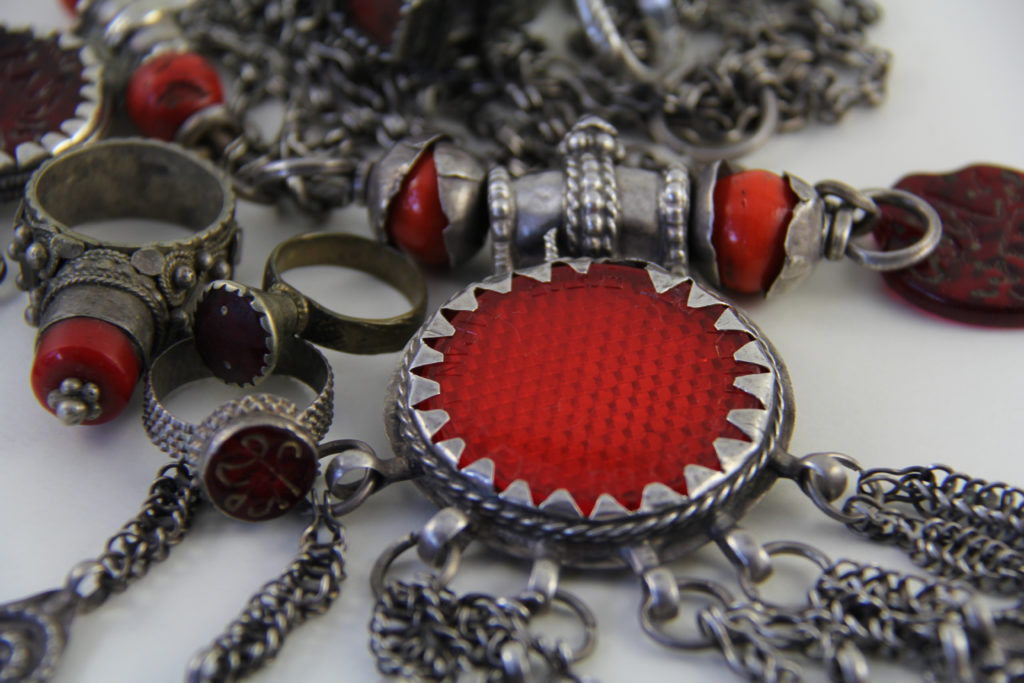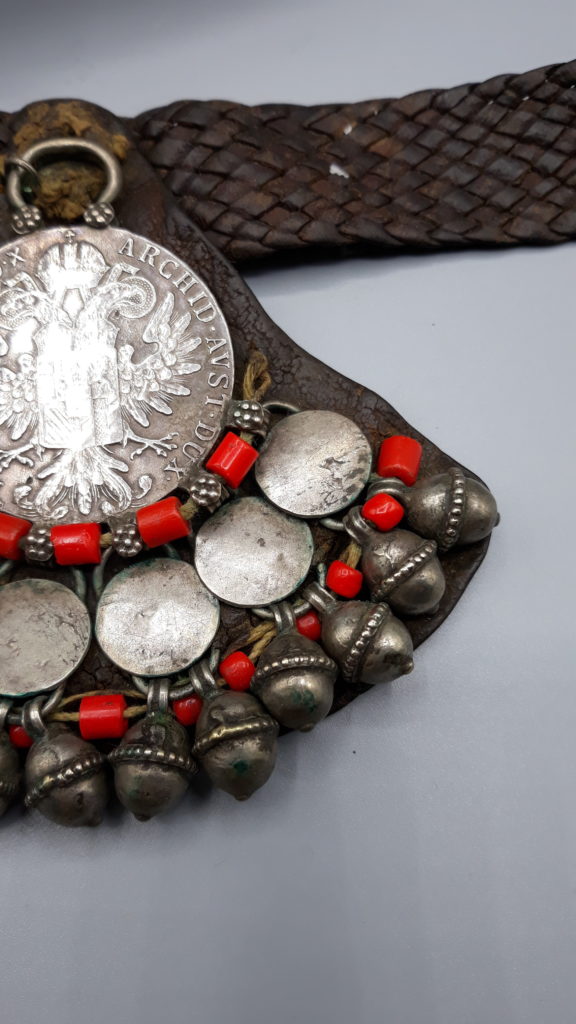One of the colours that stand out in jewellery in the Arab world is red. It is seen everywhere in the region, in both jewellery and clothing, and that is no coincidence. Why is this colour appreciated so much?
The colour of fire

A necklace from Great Kabylia, Algeria, made of silver beads with enamelled pendants and red branch Coral
Red is a fierce colour: it stands out from its surroundings and is very difficult to go unnoticed. It captures the attention of the onlooker and almost acts as a stop or danger-sign, and that capacity makes it very well suited to be an agent against evil forces. Red is also the first colour to be used by humans: already in the Early Stone Age, people buried their dead with powdered red Ochre and painted the stunning images in caves with red paint. We do not know which meaning red carried in those early days, but we do know that the ancient belief in the Evil Eye has led to persistent traditions in colours. In dress and jewellery, many civilizations did not select a colour that worked well with one’s hair or matched one’s outfit, but a colour that was generally believed to be helpful in keeping dangerous forces at a distance. Red is on the top of that list. As the colour of both danger and fire, it was thought to keep the wearer safe.
The colour of blood

A silver bracelet from Saudi-Arabia. One Coral adds a touch of red
As the colour of blood, red is also very much a colour worn by women. Blood is associated with fertility and life. Already in ancient Egypt, amulets associated with the goddesses Hathor and Isis were made of red coloured stones, and the beautiful embroidery on Palestinian dress, for example, uses predominantly red as the colour of happiness and life. A beautiful piece of dress in the collection is this Tunisian headcover made of red silk, while a bright red women’s Thawb from Bahrain shows the splendour of this colour. With this colour featuring so abundantly in costume and dress, it is no surprise that we find it in jewellery as well.
Red in jewellery

An Omani pendant set with a reflector. Depicted with it are Yemeni rings with red glass insets
Red is found in jewellery throughout the Arab world. Red-coloured elements such as glass, Coral, enamel or semi-precious stones are used widely. Coral is very much loved: both its reddish colour and its property to bring wisdom to the wearer account for its popularity. Red glass elements often include Bohemian beads that were sold all through the Middle East and North Africa. Red carnelian was used to alleviate fever or blood-related illnesses and problems such as heavy menstruation. In nineteenth-century Yemen, nomadic tribesmen wore a carnelian set in silver around their neck to stop the bleeding if they became injured. A particular example comes from Oman, where we sometimes find red reflectors set in silver. This pendant does not only possess the powers of the colour red but adds the capacity of a reflector to it: now that would certainly keep evil at a distance! Even in jewellery that holds no coloured elements, you will sometimes find a piece of red thread tied through its dangles, to add just that extra bit of security.
Where can I read more?
There are many books about jewellery. At the end of each blog post, I will share some of my favourite books with you. A few suggestions to enjoy about the use of colour are:
- Embroidering Identities. A century of Palestinian Clothing, by Iman Saca: a lovely introduction into Palestinian dress and costume, including the symbolism of colour
- Threads of Identity, by Widad Kawar: a phenomenal overview of Palestinian costume, dress and jewellery
- Encyclopedia of Embroidery from the Arab World, by Gillian Vogelsang-Eastwood: an amazing reference work of embroidery including symbolism
- Desert Silver, by myself, includes a chapter on symbolism in jewellery (including colours)
*Featured image: Head ornament from Marib, Yemen, showing red glass beads in the decoration


Latest Comments
POST YOUR OPINIONLinda MacConnell
March 9, 2020Stunning beautiful pieces.
Sigrid van Roode
March 9, 2020Thank you so much Linda!
Magic All Around - The Zay Initiative
December 17, 2020[…] helps to protect the wearer and keeps evil at a distance. In earlier blog posts we have looked at the colour red and how renderings of animals and the skies work their magic for the wearer. Let’s have a look at […]
Traditional hair ornaments from the North-Africa - The Zay Initiative
October 13, 2022[…] attract good fortune or health (for more information on the use of colour see Sigrid van Roode’s blog post on this subject). A leather brow ornament with beads from the Maghreb is a good example. This is worn on a […]